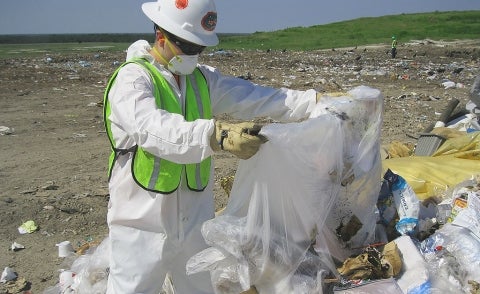Note: Yale School of the Environment (YSE) was formerly known as the Yale School of Forestry & Environmental Studies (F&ES). News articles and events posted prior to July 1, 2020 refer to the School's name at that time.

Americans throw out a wide variety of stuff every year, but understanding just what types of waste are being produced — and where it ends up — has been elusive.
Recent work by Yale researchers, published in the Journal of Industrial Ecology, takes a major step in measuring just what is in the more than 200 million tons of waste that are discarded each year.
Although accounts of household waste generation have been published for years, previous estimates have lacked geographic specificity and relied primarily on economic data. Therefore, it has historically been difficult for individuals to consider how they might better handle their waste — or to understand the economic and environmental consequences of waste management.
“Much concern, rightfully, in the waste space recently has been on individual types of wastes.” said Jon Powell, a researcher at the Yale Center for Industrial Ecology and lead author of the study. “Many different groups are mobilizing to tackle challenges with food waste, plastic waste, textile waste, electronic waste, and others. We’ve assembled an approach that serves as a comprehensive way to track waste disposal across the U.S. with high spatial fidelity across about 10 major waste types.”
The paper was co-authored by Marian Chertow, associate professor of industrial environmental management at the Yale School of Forestry & Environmental Studies.
What makes the Yale team’s approach novel is their development of multiple high-resolution data sets, broken out across more than 850 landfills in the U.S. and combining this information with statistically relevant waste-sorting efforts that measured dozens of individual discarded waste materials across the country. Taken together, the result is a waste disposal estimate that informs what materials go where, how much, and when.
“We are excited about the applications that can flow from our approach,” said Powell. “Knowing where the largest amounts of different material types are can spur investment for smarter materials recovery, highlight the biggest opportunities for more materials recovery, or even provide further materials collection and aggregation opportunities at disposal sites. We highlight how various actors in the waste value chain could benefit from these improved analytics.”
The authors will continue updating and expanding their analysis as more data from around the country are published.
Jon Powell, the paper’s corresponding author, can be reached at jon.powell@yale.edu.
Recent work by Yale researchers, published in the Journal of Industrial Ecology, takes a major step in measuring just what is in the more than 200 million tons of waste that are discarded each year.
Although accounts of household waste generation have been published for years, previous estimates have lacked geographic specificity and relied primarily on economic data. Therefore, it has historically been difficult for individuals to consider how they might better handle their waste — or to understand the economic and environmental consequences of waste management.
“Much concern, rightfully, in the waste space recently has been on individual types of wastes.” said Jon Powell, a researcher at the Yale Center for Industrial Ecology and lead author of the study. “Many different groups are mobilizing to tackle challenges with food waste, plastic waste, textile waste, electronic waste, and others. We’ve assembled an approach that serves as a comprehensive way to track waste disposal across the U.S. with high spatial fidelity across about 10 major waste types.”
The paper was co-authored by Marian Chertow, associate professor of industrial environmental management at the Yale School of Forestry & Environmental Studies.
What makes the Yale team’s approach novel is their development of multiple high-resolution data sets, broken out across more than 850 landfills in the U.S. and combining this information with statistically relevant waste-sorting efforts that measured dozens of individual discarded waste materials across the country. Taken together, the result is a waste disposal estimate that informs what materials go where, how much, and when.
“We are excited about the applications that can flow from our approach,” said Powell. “Knowing where the largest amounts of different material types are can spur investment for smarter materials recovery, highlight the biggest opportunities for more materials recovery, or even provide further materials collection and aggregation opportunities at disposal sites. We highlight how various actors in the waste value chain could benefit from these improved analytics.”
The authors will continue updating and expanding their analysis as more data from around the country are published.
Jon Powell, the paper’s corresponding author, can be reached at jon.powell@yale.edu.
Published
September 5, 2018